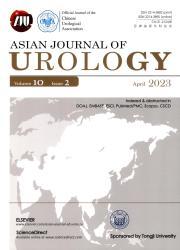机器人辅助根治性前列腺切除术后cT2cN0M0前列腺癌不良病理变化的风险分析:一项基于人群的研究结果
IF 2.4
3区 医学
Q2 UROLOGY & NEPHROLOGY
引用次数: 0
摘要
目的探讨机器人辅助根治性前列腺切除术(RARP)后临床肿瘤分期2c (cT2c)前列腺癌(PCa)患者不良病理改变(APCs)(升级、上分期和阳性手术切缘[PSM])的临床病理预测因素。方法纳入2018年1月至2022年12月在北京大学第一医院行前列腺活检并随后进行RARP的cT2cN0M0 PCa患者,活检和RARP间隔≤90天。进行单变量和逐步多变量logistic回归分析,以确定与APCs相关的独立危险因素。基于这些预测模型构建了nomogram。通过受试者工作特征曲线、决策曲线分析和校准图来评估nomogram的性能。结果共纳入423例符合条件的cT2cN0M0 PCa患者。在我们的队列中,升级率、占上风率和PSM率分别为33%、51%和35%。逐步多因素logistic分析表明,PSA密度和系统活检中阳性核的百分比与APCs的发生显著相关。前列腺影像学报告与数据系统评分、PSA密度、针刺活检标本国际泌尿病理学会分级组(IGG)(或临床IGG [cIGG])与升级有显著相关性。PSA密度、系统活检中阳性核的百分比和每个患者所有核中最大肿瘤百分比(LTP)与抢先期显著相关。PSA密度和LTP与PSM有显著相关性。基于这些结果,开发了四种图。受测者工作特性曲线、决策曲线分析和校准图表明,诺图具有良好的准确性。结论建立的预测模型有助于早期识别高危PCa,优化cT2cN0M0型PCa患者的临床决策。本文章由计算机程序翻译,如有差异,请以英文原文为准。
Risk analysis of adverse pathological changes in cT2cN0M0 prostate cancer after robot-assisted radical prostatectomy: Results from a population-based study
Objective
To explore clinicopathological predictors of adverse pathological changes (APCs) (upgrading, upstaging, and positive surgical margin [PSM]) after robot-assisted radical prostatectomy (RARP) in clinical tumor stage 2c (cT2c) prostate cancer (PCa) patients.
Methods
From January 2018 to December 2022, cT2cN0M0 PCa patients who underwent prostate biopsies and subsequent RARP at the Peking University First Hospital with an interval between biopsy and RARP of ≤90 days were included. Univariable and stepwise multivariable logistic regression analyses were performed to identify independent risk factors associated with APCs. Nomograms were constructed based on these predictive models. The performance of the nomograms was evaluated by receiver operating characteristic curves, decision curve analyses, and calibration plots.
Results
A total of 423 eligible cT2cN0M0 PCa patients were included. The rates of upgrading, upstaging, and PSM in our cohort were 33%, 51%, and 35%, respectively. The stepwise multivariate logistic analysis suggested that PSA density and the percentage of positive cores in systematic biopsy were significantly associated with the occurrence of APCs. The score of the Prostate Imaging Reporting and Data System, PSA density, and the International Society of Urological Pathology grade group (IGG) of needle-biopsy specimens (or clinical IGG [cIGG]) were significantly associated with upgrading. The PSA density, percentage of positive cores in systematic biopsy, and largest tumor percentage in all cores of each patient (LTP) were significantly associated with upstaging. The PSA density and LTP were significantly associated with the PSM. Based on these results, four nomograms were developed. Receiver operating characteristic curves, decision curve analyses, and calibration plots implied that the nomograms exhibited excellent accuracy.
Conclusion
The predictive models we developed could help to identify high-risk PCa early, and optimize clinical decisions of cT2cN0M0 PCa patients.
求助全文
通过发布文献求助,成功后即可免费获取论文全文。
去求助
来源期刊

Asian Journal of Urology
UROLOGY & NEPHROLOGY-
CiteScore
4.00
自引率
3.80%
发文量
100
审稿时长
4 weeks
期刊介绍:
Asian Journal of Urology (AJUR), launched in October 2014, is an international peer-reviewed Open Access journal jointly founded by Shanghai Association for Science and Technology (SAST) and Second Military Medical University (SMMU). AJUR aims to build a communication platform for international researchers to effectively share scholarly achievements. It focuses on all specialties of urology both scientifically and clinically, with article types widely covering editorials, opinions, perspectives, reviews and mini-reviews, original articles, cases reports, rapid communications, and letters, etc. Fields of particular interest to the journal including, but not limited to: • Surgical oncology • Endourology • Calculi • Female urology • Erectile dysfunction • Infertility • Pediatric urology • Renal transplantation • Reconstructive surgery • Radiology • Pathology • Neurourology.
 求助内容:
求助内容: 应助结果提醒方式:
应助结果提醒方式:


